“Cruising J-Town” commemorates 110 years of participation in and contributions to California’s car culture by members of the Japanese American community.
A special JANM exhibit gives an eye-opening look at
community history, healing and for one family, a car that carried them to freedom.
By Rob Buscher, P.C. Contributor
In Los Angeles’ Little Tokyo, the Japanese American National Museum opened on July 31 a special exhibit titled “Cruising J-Town,” about the history and culture of the automobile, its influence on Japanese Americans and the community’s unique contributions to car culture in Southern California.
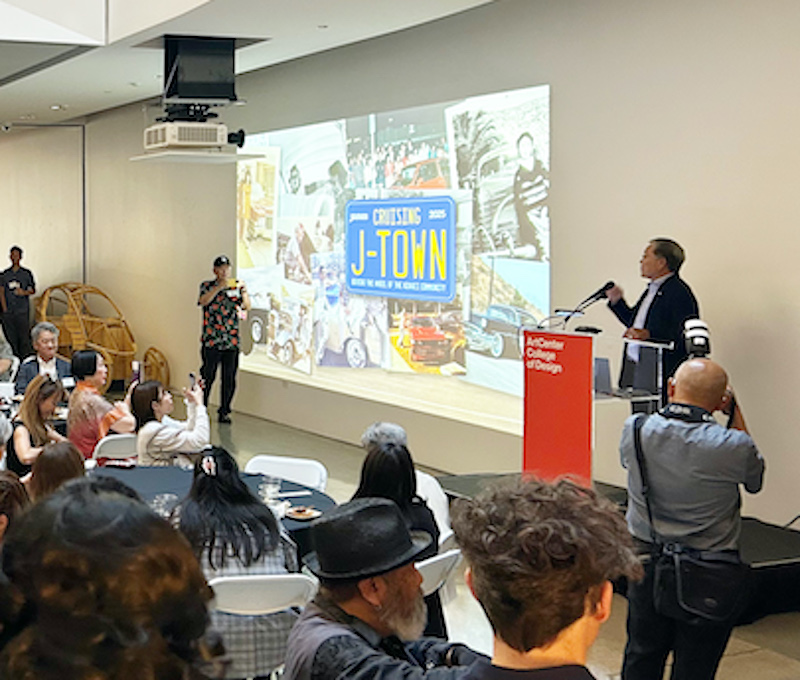
JANM Board President William Fujioka addresses the gathered crowd during the exhibit’s opening reception. (Photos: Rob Buscher)
Produced in collaboration with ArtCenter College of Design in Pasadena as part of the JANM on the Go series, the exhibit features more than 100 objects, including rare photographs and home movies, car memorabilia, concept car designs and five classic cars, each rooted in key moments in Japanese American history.
Spanning more than 110 years, the exhibit begins with a section on Issei drag racers that features a news clipping titled, “Japanese Speed Demons Circle Old Ascot Park.” Linking the timeline of auto culture in Los Angeles to the growing Nikkei diaspora in the early 1900s, this section explores the evolution of car culture from a community-centered perspective.
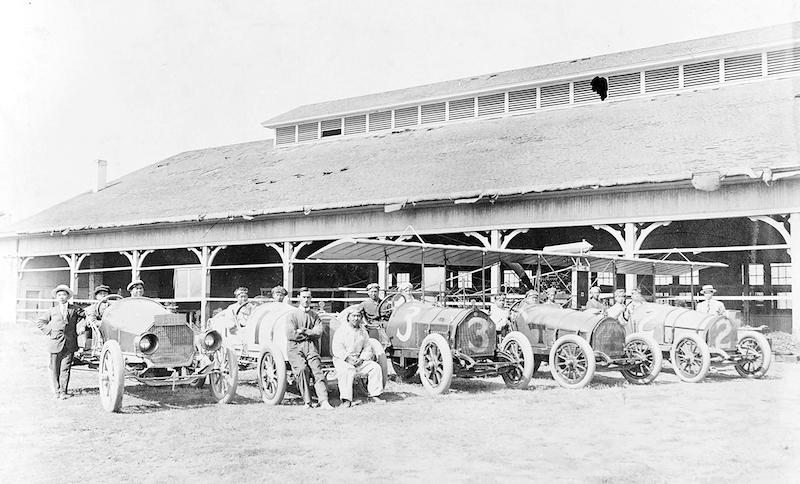
The first Japanese auto race at Ascot Park in 1915
It also demonstrates how Japanese Americans experienced cars primarily as utilitarian work vehicles in the prewar era. As truck farmers and gardeners, cars granted autonomy to many Issei who sought self-employment as a means to build wealth for their families.
Another section covers the role that automobiles played in the actual logistics associated with forced removal during World War II, transporting persons and possessions to temporary detention centers. Later in the War Relocation Authority camps, a motor pool (which included some vehicles forfeited by incarcerees) was used to transport building materials and other goods the lengthy distance across camp.
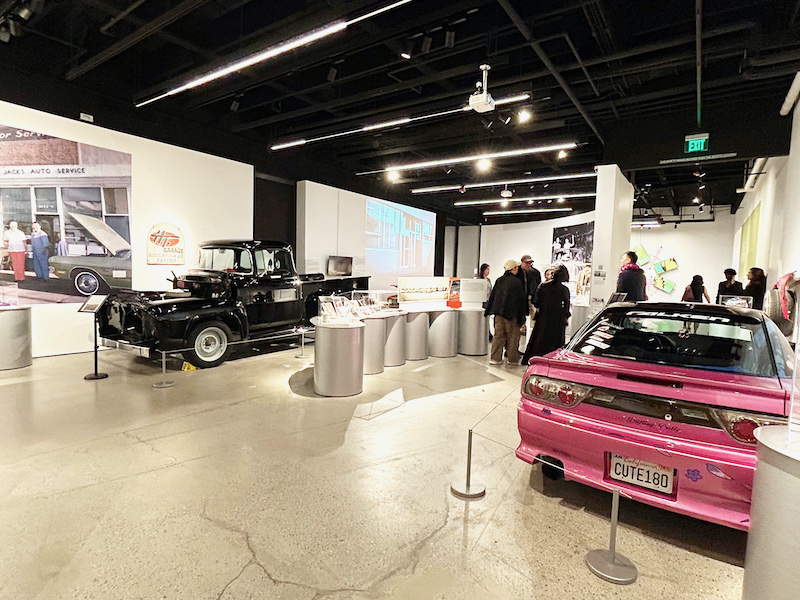
A look at the exhibit gallery
The exhibit then moves into the hot rod era, when many Sansei started their own car clubs as suburbanization coincided with the postwar stabilization of household finances in the late 1950s-’60s.
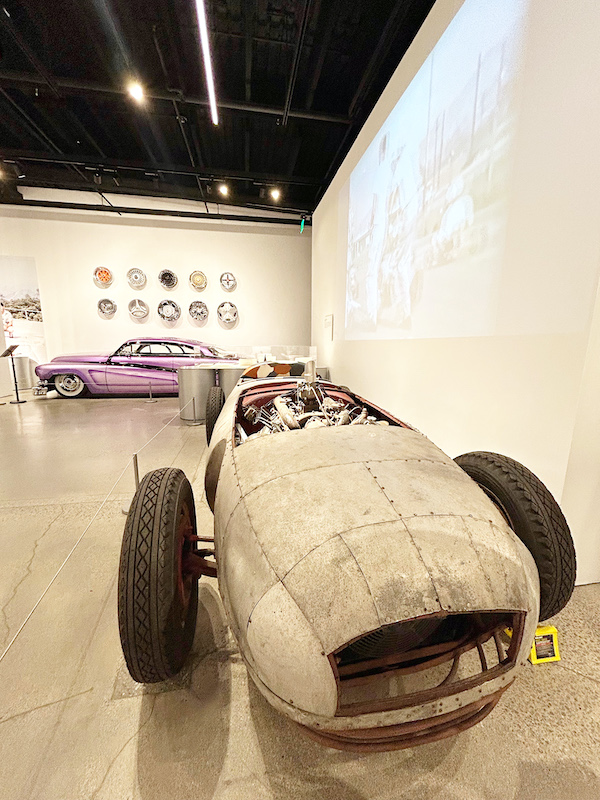
The meteor and another custom car in the exhibit
While car clubs were part of a broader cultural movement happening in that era, unique to the Japanese American experience were the Sakanaya — fish monger trucks that essentially functioned like Japanese grocers on wheels for the suburbanized Japanese American communities of Greater Los Angeles.
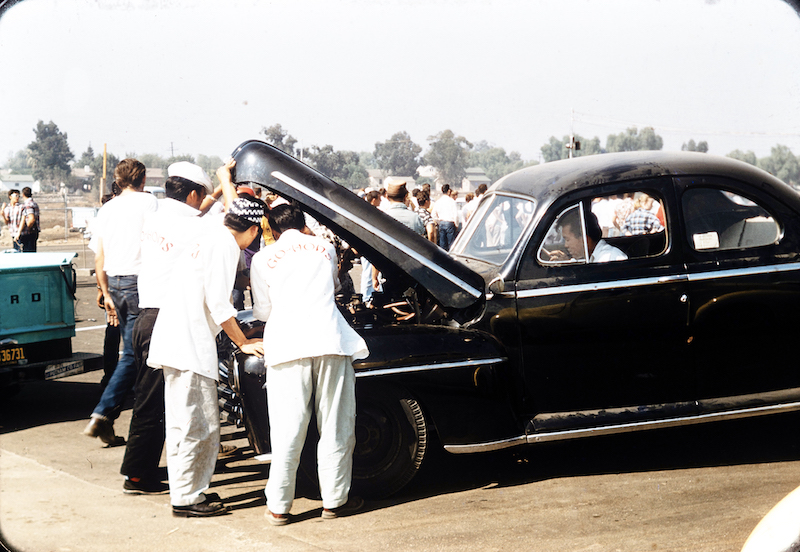
Members of Go-Hans roadster car club (Photo: Courtesy of JANM)
This period also saw the expansion of Nikkei-owned gas stations and auto repair shops as a common sight throughout Southern California. The exhibit ends with a section detailing several accomplished Japanese American automobile engineers and designers. The final section also includes several displays related to Japanese imports and their impact on contemporary custom car culture.
Exhibit curator Dr. Oliver Wang has spent years researching and writing about Japanese American car culture, though he admitted to not being a car person himself in remarks given during the exhibit’s opening reception.
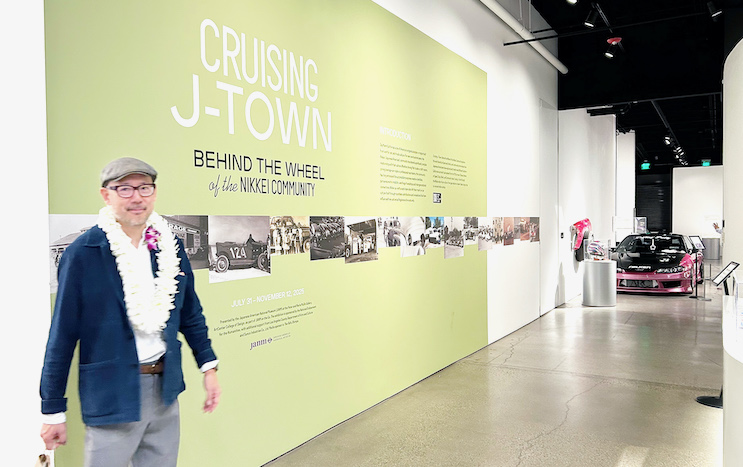
Oliver Wang in front of the exhibit title
“This room is filled with car people, many of them would know within 20 seconds that I am not a car person,” explained Wang. “But as my wife, Sharon, has observed, I’m a car person, person. Meaning that as a writer, as a scholar and now as a curator, I’ve spent the past four decades deeply invested in documenting and sharing Asian American stories and histories, especially because those stories have so rarely been included in literature or history books or museum exhibitions.”
Wang encouraged the audience to view cars as a means to understand the history and culture of Japanese America. He elaborated, “Japanese American car culture is, pardon the pun, a powerful vehicle through which to tell personal family and community stories because cars and trucks have been such a vital part of this community’s history, going back well over 100 years. . . . ‘Cruising J-Town’ isn’t really about cars. It’s about a community of people who have been part of L.A.’s social and cultural fabric for six generations and counting. Car culture is a way to tell these stories, but it’s the people who come first always.”
In an interview conducted during the opening weekend of the exhibit, Wang shared that his ultimate goal was for the Japanese American community to feel seen and heard.
Although Wang himself is Chinese American, his Japanese American wife and her family’s relationship to cars were part of the inspiration for the exhibit. His father-in-law, Don Mizota, is a car guy and was one of the first interviewees included in the project; he previously owned a 1963 Stingray.
Wang reflected on some lessons learned from working with the community: “[Japanese Americans] deserve to have their humanity centered through the everyday ways in which cars and trucks form this commonality that people can relate to. It’s a touchstone in the same way that food and music can be. Everyone’s got a car story they can connect with.”
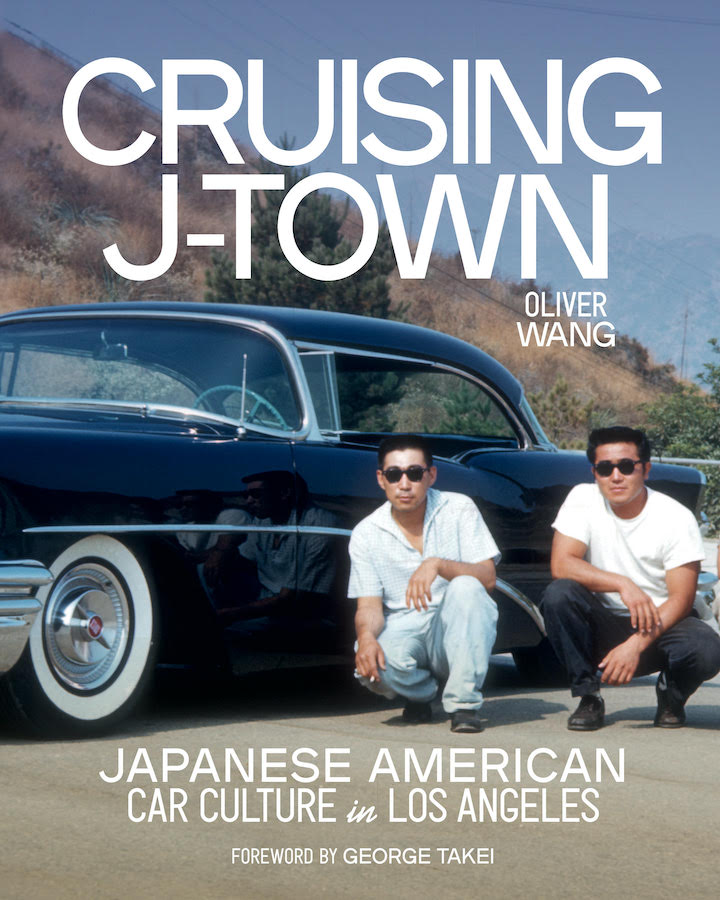
“Cruising J-Town” is a new exhibit featuring Japanese American car culture history. A companion book, written by curator Oliver Wang with a foreword by George Takei, is available for purchase now.
Photo: Courtesy of JANM
The exhibit’s companion book, authored and edited by Wang, features excerpts from the interview he conducted with his father-in-law and dozens of additional articles spanning the exhibit narrative and other topics that did not fit into the gallery setting.
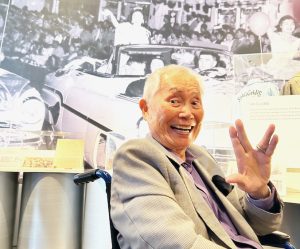
George Takei, who wrote the foreword to the “Cruising J-Town” companion book, tours the exhibit.
Published by Angel City Press, the book’s foreword, written by George Takei, succinctly articulates the highly emotional connection Japanese Americans held with their cars before camp, the symbolic loss of selling or abandoning their vehicles during the war and a physical embodiment of regaining wealth and status in the postwar resettlement era. The 272-page book is illustrated with vintage and contemporary photographs and is available for purchase at JANM’s online store.
When asked about particularly memorable interactions during the opening weekend of the exhibit, Wang responded, “Seeing the 50-person Marumoto clan come through, meeting members of the family and watching them interact with other patrons to share their family story . . . these kinds of people who don’t know each other but are still finding a way to connect with each other. That’s magical, and at some level, I understood that could happen, but to actually see it happening is enormously gratifying.”
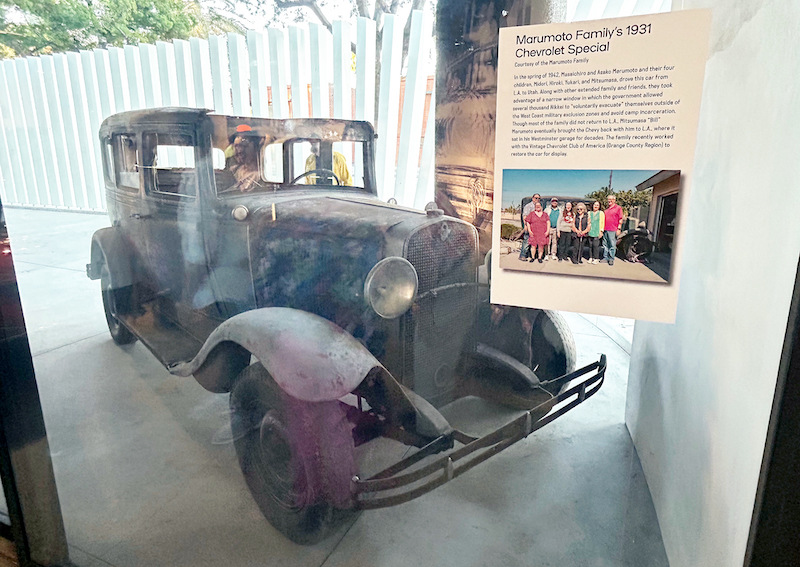
The Marumoto family’s 1931 Chevrolet Special, which was on display during the exhibit’s opening reception. The car transported the family to Utah after they “voluntarily evacuated” themselves following the bombing of Pearl Harbor and the onset of World War II.
A late addition to the exhibit checklist, the Marumoto family’s 1931 Chevrolet sedan was featured during opening weekend only. The car was used to explore the role that vehicles played during the so-called “voluntary evacuation” when more than 5,000 Japanese Americans self-evacuated from the exclusion zone in the aftermath of Pearl Harbor.
Few families were able to make the journey as it required an employment guarantor outside of Military Area 1 to sponsor each adult of working age. Additionally, there was a limited window between late-February 1942 and March 27 when Western Defense Command decided to close the border of California to Japanese Americans.
A majority of the “voluntary evacuees” used personal vehicles to drive themselves, their families and limited belongings that they could fit with them in their cars.
Purchased by Masaichiro Marumoto, the Chevy sedan was originally used as a leisure vehicle for weekend trips from the Marumoto farmstead in Gardena, Calif., to Los Angeles’ Little Tokyo, where the family did its weekly grocery shopping and worshipped at the old Nishi Hongwanji Buddhist Temple on First Street.
In the 12 years prior to the war, the Marumotos did well for themselves as proprietors of a successful farm business – even owning a second vehicle – a work truck that was used in the fields and for transporting their crop yield.
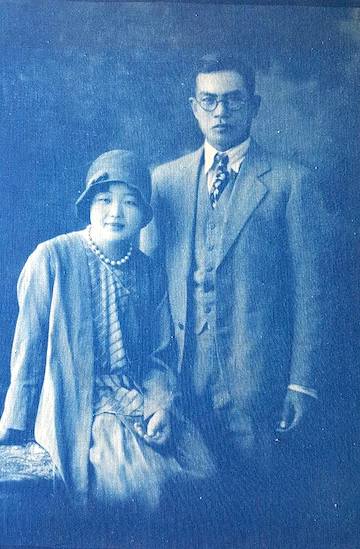
Masaichiro and Asako Marumoto in an undated family photo
After Masaichiro’s wife, Asako, had an emergency appendectomy in early 1942, they were cautioned by the doctor that the temporary assembly centers might not have adequate medical facilities for her continued care. They made the difficult decision to chance fate by leaving the exclusion zone with their four children and whatever they could carry in a small trailer hitched to the rear of their car. Together with Masaichiro’s younger brother, Kenichi, and Asako’s cousin, they made a three-car caravan in exodus from the exclusion zone.
The favored destination for self-evacuees was Colorado, where Gov. Ralph Carr welcomed Japanese Americans to resettle in his state, an extremely unpopular political position that ultimately cost him his re-election campaign.
In the Marumoto family’s case, they chose Utah, where a distant uncle of Asako, Asakichi Okuda, resided in the farmlands to the north of Salt Lake City. Having worked for some of the farm owners in Mormon pioneer country, Asakichi was able to broker a sponsorship for his niece, Asako, and her husband, Masaichiro, to self-relocate along with their four children in March 1942. Of the six people who took the perilous journey across three state lines, only one survives today – Yukari Marumoto Mikesell.
Yukari turns 90 on Dec. 25 and was just 6 years old when she rode to freedom in her parents’ car. She credits father Masaichiro’s spirit of resistance for the family’s unorthodox response to the government evacuation orders.
“My father was born under the sign of the tiger. My romantic view is that a tiger cannot be caged. So, that’s why we moved,” Mikesell recalled.
Selling what they could, Masaichiro gave away the family’s truck for free to the man who purchased his beloved work horses that he named Dodge and Aka.
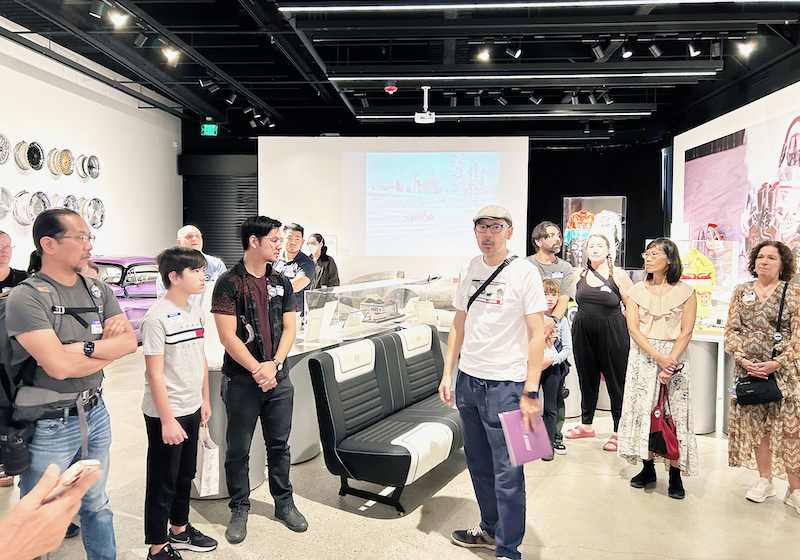
Oliver Wang gives members of the Marumoto family a curator’s tour of the exhibit.
Like other families who went to camp, the Marumotos burned many of their prized Japanese possessions. Items that were too precious to destroy were buried in the ground, such as the family sword. As they drove away from the farmstead that had been the manifestation of their American Dream, Mikesell remembers her father singing “Tabi no Yokaze” (Night Wind’s Journey), a song from the popular 1938 film “Aizen Katsura.”
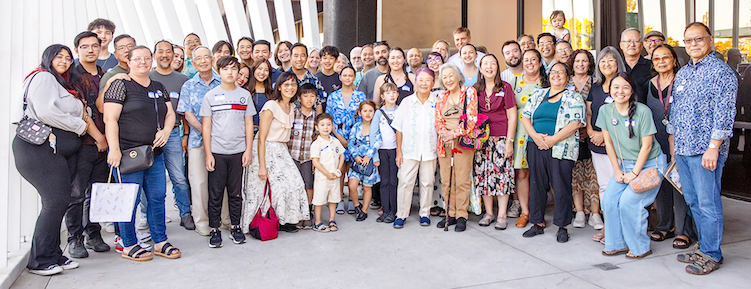
Members of the Marumoto family gather for a picture at the exhibit.
Photo: Sheldon Marumoto
The granddaughter of Masaichiro and Asako, Sandra Mikesell Buscher organized a 50-person family reunion in conjunction with the opening weekend of “Cruising J-Town,” in part to celebrate the car’s inclusion in the exhibit, but also as a means of providing closure to a dark chapter in the family’s history.
Buscher reflected on a particularly impactful aspect of her grandparents’ journey, recalling, “One of the things I found very inspirational: My grandfather, as they were leaving the farmhouse after they burned possessions and broke dishes and setting out into the unknown, he sang this song, ‘Tabi no Yokaze.’ The first verse says, through flowers and sleep you survive, that’s the path a man must walk, don’t cry for me hori-hori bird, I walk alone in the moonlight.”
That was only the beginning of a journey that would test the Marumoto family as they navigated difficult mountainous and desert terrain in an era before the interstate highway system.
To this day, Mikesell remembers the constant feeling of dread she and her family experienced on the road. One incident that transpired during their first night set the tone for the remainder of their trip.
“The first night,” Mikesell recalled, “we stopped because it was dark. My father had been driving a long time, and he had to rest. We were woken up by soldiers who surrounded us with their guns drawn.” Unbeknownst to them, the family had accidentally camped on government land on the outskirts of an U.S. Army installation.
Mikesell’s 10-year-old brother, Hiroki, was the only member of the family with a strong enough command of the English language to talk the soldiers down and explain the misunderstanding. After producing the sponsor letters from their employment guarantors, the family was allowed to continue on their way — but not without forfeiting Hiroki’s BB gun and a transistor radio. Mikesell continued, “From then on, they were scared to turn off the car. They were afraid to stop, so they drove through the nights.”
The three cars split up and drove at their own pace as they tried to reach their destination as quickly as possible. With four young children, the Marumoto family pulled up the rear, giving their only road atlas to Asako’s cousin, who could travel the fastest without a trailer hitched to his vehicle.
Mikesell explained how her parents navigated the remaining route without a map: “When [the lead car] made different turns at major roads, which veered off of the main roads, they would toss one of the zabutons (cushions) on the ground,” she remembered.
In addition to the challenge of navigating unknown terrain without a map, the family also had to contend with the prospect of anti-Japanese racism. Along the way, signs reading “No Japs” became a frequent spectacle.
“Near the border of Nevada, my father parked the car a few blocks outside of this mountain town. He walked by himself into the town, and when he went into the store, they didn’t want him there,” Mikesell recalled. “They only let him buy his bologna and a loaf of bread to get him to leave town.”
While African American motorists of the era had “The Negro Motorist Green Book” to tell them which towns and businesses were safe — and which were best to avoid — Japanese American self-evacuees had no such guidance.
With each stop they took for gasoline, bathroom breaks and food — the Marumoto family risked their lives only months after the attack on Pearl Harbor when anti-Japanese fervor was at its peak.
Mikesell remembers clearly the moment she understood the level of danger her family faced while on the road.
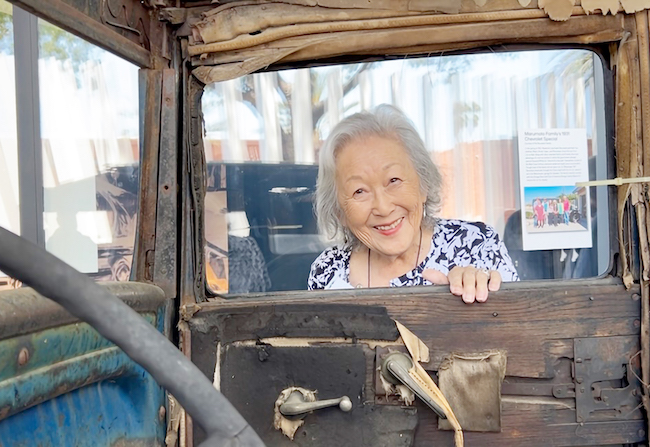
Yukari Marumoto Mikesell with her family’s car
“One of these times, my dad left us on the outskirts of town, we were fighting, you know how kids argue. My mother finally turned around and yelled how can you be so naughty and fight when you don’t know if your father’s going to come back? It was something I’ll never forget.”
After arriving in Utah, the family then used the car as a means of transportation and as a work vehicle until 1954, when they purchased their next car. Working as sharecroppers, the Marumoto family bought a small plot of land from the Mormon farmers whose land they worked and built a new house.
There in the yard at the edge of the farm field the car sat for several decades until it was towed to the garage of Mitsumasa “Bill” Marumoto, the youngest son of Masaichiro, in Westminster, Calif. Bill and his brother, Hiroki, had hoped to restore the car one day, but both passed away before they were able to do so.
When the Marumoto family learned of the “Cruising J-Town” exhibit, Buscher and her cousin, Brandon Marumoto, contacted a local car club in Orange County in the hopes that they might stabilize it for inclusion in the main gallery display.
Unfortunately, the car’s wooden frame suffered significant wood rot in the years it was exposed to the elements, and the work was unable to move forward in time for the exhibit.
Still, Wang, JANM VP of Exhibitions and Art Director Clement Hanami and the exhibitions team at ArtCenter were able to accommodate the car by parking it outside a sliding glass door visible from inside the main gallery.
Following its inclusion in the opening weekend of the exhibit, the car has now entered the possession of a private collector, who hopes to restore it to working condition.
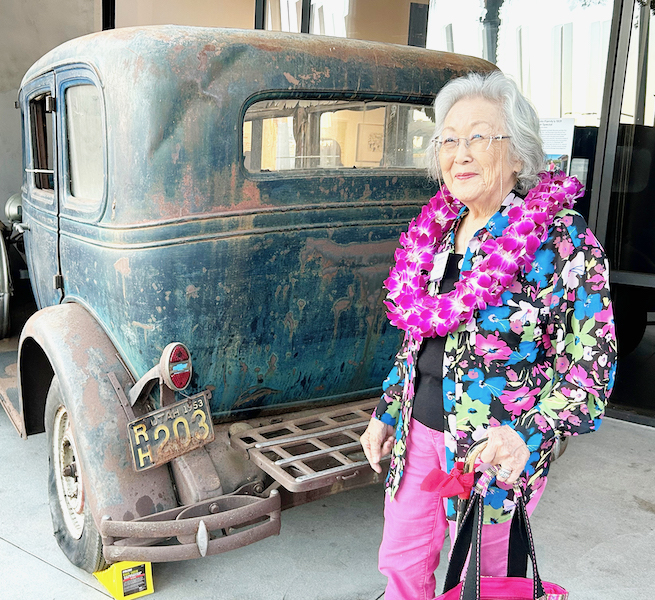
Yukari Marumoto Mikesell bids farewell to her family’s car.
Reflecting on the car’s journey as she bid adieu to the storied vehicle, Mikesell reminisced, “It’s not ours anymore, but it’s in good hands. It’ll do whatever gets done to it. It’s lived a good life. And it brought the family together.” Mikesell took a final glance at the car as she walked back into the gallery, singing a few bars of “So Long, Farewell.”
All of Masaichiro and Asako’s children met their spouses as a result of their resettlement in Utah. The Sansei, Yonsei and Gosei descendants who now make up more than 50 members of the Marumoto clan exist today because of this 1931 Chevy sedan and their family’s March 1942 journey to freedom.
‘Cruising J-Town’ is free and open to the public Wednesdays-Sundays from Noon-5 p.m. through Nov. 13 at the Peter and Merle Mullin Gallery at ArtCenter College of Design. For more details on special events and other resources related to the exhibit, visit www.janm.org/exhibits/cruising-j-town.




